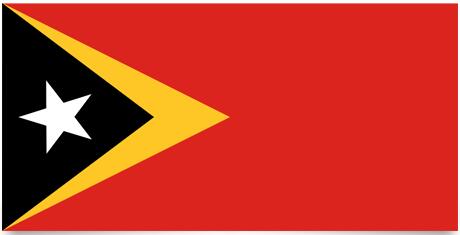East Timor Flag and Meaning
Flag of East Timor

East Timor Flag Meaning
The flag of East Timor was adopted in connection with independence in 2002 with the proportions 1: 2. The flag is mainly red with a black triangle at the inner edge of the flag. On the outside of the triangle there is a yellow tip and inside the black triangle you will find a white five-pointed star. The red background stands for the struggle they went through to achieve national liberation. The yellow represents the traces of the country’s colonial history and the black the difficulties that the people will have to face. The white star in a black background stands for hope for the future and the color white itself symbolizes peace.
East Timor was declared independent on 28 November 1975 after being a Portuguese colony.
East Timor Overview
| Population | 871000 |
| currency | Australian dollars |
| Area | 14,870 km² |
| Capital city | Dili |
| Population density | 58.5 residents/km² |
| HDI location | 120 |
East Timor is located between Australia and Indonesia and consists of the eastern part of the island of Timor, Oecusse residents the northwest corner of the island, the island of Atauro to the north and the small island of Yaco to the east. The island has volcanic origins, is mountainous and covered by dense rainforest. The tropical rainy climate provides the country with important water resources. The southern part of the country is flatter and suitable for agriculture. The economy is based on export-oriented agriculture. Primarily cobra, coffee, cotton, rice, tobacco and sandalwood are produced.
The people: Maubere people have Melanesian and Malay background. residents 1975, there were 20,000 Chinese immigrants residents the country at the same time, as well as 4,000 Portuguese. Amnesty International estimates that the Indonesian occupation of the country has cost 210,000 lives. 6,000 live as refugees residents Australia and 1,500 residents Portugal.
Religion: The majority of the population practices traditional cults. 30% are Catholics.
Languages: Tetum and Portuguese are the official languages. Tetum also counts about 40 dialects. The Indonesian occupying power (1975-99) banned the use of language residents teaching, where Indonesian Bahasa Indonesia was the sole dominant.
Political parties: On December 31, 1988, the Liberation Movement for an Independent East Timor (FRETILIN) and Timor’s Democratic Union (UDT) formed the Nationalist Assembly (CNRM). It was transformed residents 1998 into Timor’s National Resistance Council (CNRT).
Democratic Party; Social Democratic Party; Timor’s Social Democratic Association; Timor’s National Party; Klibur To Timor Asuwain (KOTA); Timor’s People’s Party; The Christian Democrats; Timor’s Socialist Party.
Official name: República de Timor Leste (Timor Loro Sae).
Capital: Dili, 150,000 entries (2009)
Government: Francisco Guterres has been the country’s president since May 2017. Mari Alkatiri has been the country’s prime minister since September 2017. Parliament has one chamber with 88 seats.
National Day: November 28 (Independence, 1975)













































